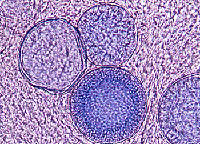Today we use the term «plague» To determine something terrible. About the history and superstitions associated with this ailment, as well as how can you catch the plague and recover from it, read this article.
Content
 Plague is known to humanity since ancient times, when this disease carried millions of lives and because of the weak development of medicine was practically synonymous. One of the first well-known epidemics of the plague broke out in 551.NS. in the Middle East and lasted almost 30 years. She claimed the life of 20 million people.
Plague is known to humanity since ancient times, when this disease carried millions of lives and because of the weak development of medicine was practically synonymous. One of the first well-known epidemics of the plague broke out in 551.NS. in the Middle East and lasted almost 30 years. She claimed the life of 20 million people.
In 1090, the disease touched and Rus. For a week, more than 10 thousand people died from her only in one Kiev. Less strong epidemics that came from Poland and Western European countries affected the territory of modern Russia in the XIII, XIV and XVIII centuries.
One of the most terrible epidemics of the past millennium broke out in Europe in 1348. According to rumors, they brought it from China. She «Disappeared» 15 million people, thereby reducing the population of the European part of the continent on a quarter.
Since medicine against the plague was powerless, she was given almost a devilish character. This disease was perceived as the miscarios of unclean, as God's Kara, who fell into sinful Europe. It is not surprising that the methods of combating the infection were relevant. In Islamic countries, the only deliverance from the plague was considered prayer and strictly execution of religious rites, and the Holy Inquisition was offered their own panacea in the Catholic. Each new case of infection has become a reason for the witch hunt.
In addition to people, suffered from holiness and animals. The main culprits of the spread of infection were declared cats - they say they are servants of the devil and are subject to extermination. However, this matter did not save. After the cities were disappeared from the cities, their rats were filled, which were expanding the disease even faster.
Now the main cause of large-scale epidemics is the nightmare antisanitary, which reigned in European cities. However, then the importance of hygiene was not appreciated, and people deliberately trying to wash out and clean their home, because they were afraid that the disease spreads with water. According to historians, even the most noble Parisians, famous for their love for aesthetics, were exclusively used by spirits and aromatic oil to hide their uncleanness.
The bacteria of the plague live and multiply in a cool wet environment and can be maintained in it for many years. A person can infect plague through the respiratory tract, singing infected food or from an insect bite (most often flea). The most frequent pedestals of the disease become minor rodents, including mouse-wool and rats, as well as hares and foxes.
The plague is extremely difficult, with painful and unpleasant symptoms, although quite quickly. The most frequent manifestation of the plague is a strong purulent inflammation of lymph nodes (in the area of the groin, neck, armpits), fever, in the second stage of the disease - lesion of lungs and strong bloody cough. The patient starts muscle pain, dizziness, consciousness is confused, sometimes hallucinations appear. The average period of the disease is about a week, after which the patient is dying without treatment.
Up to the twentieth century, the plague was not treated. The only therapy was cutting the so-called bubons (purulent bubbles around lymphatic nodes), and the means of limiting the epidemic - quarantine. At the beginning of the twentieth century, Russian scientist Vladimir Khavkin opened the first vaccine in the world against the plague, however, the strains of pathogens of this disease exists such a set that it is not possible to develop antibodies from each of them possible.
Therefore, the disease is being treated with antibiotics: the intensity and effectiveness of treatment depends on how early it began. Despite the fact that the extensive epidemics of the plague stayed in the past, it dies every year to 2500 people, which is approximately 5-7% of all infected. Periodically, outbreaks of disease are recorded in Asia, Africa and South America. In Russia, the cases of infection of Chumay did not register since 1979.









